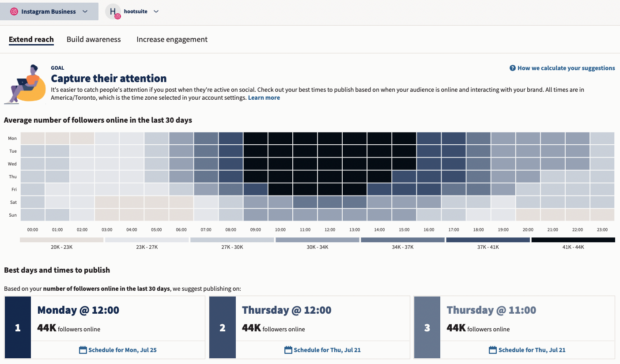If your Instagram growth strategy is all about pleasing the platform’s algorithm, you’re falling behind the times. As social networks shift to allow users to discover content with greater intention, it’s time to master Instagram SEO.
Keep reading to learn the best ways to optimize your profile and content and get seen by the people who are actively searching for brands and products similar to yours.
Bonus: Download a free social SEO checklist and follow pro tips for Facebook, Instagram, TikTok, YouTube, Twitter, and LinkedIn to get your posts seen by more people.
What is Instagram SEO?
Instagram SEO is the practice of optimizing your Instagram content to be discovered in search results on the platform.
When someone uses the Instagram search box to look up words related to your business, you want your account or content to appear near the top of the list—and Instagram SEO tactics can help you achieve this goal.
Instagram search results include relevant content, accounts, audio, hashtags, places, and Reels.

There are also keyword results pages meant for browsing. Each keyword results page (indicated with a magnifying glass) is essentially an Explore page for that specific keyword.

Below, we break down the different “types” of Instagram SEO, or parts of your profile that can be optimized for greater visibility.
Instagram bio SEO
Your Instagram bio is an important component of SEO for Instagram. It’s a critical place to include relevant keywords and search terms.

Source: @ellecordova
Use your Instagram bio to provide context for both human visitors and the bots that return search results.
Consider these points when writing your bio for Instagram SEO:
- Who are you?
- What is your content about?
- What words will help people, and the Instagram search engine, find your content?
Pro tip: Need help rewriting a bio that hits all the SEO for Instagram points? Try our free Instagram bio generator and get an optimized bio in just a few clicks.
Instagram name SEO
Instagram name SEO refers to choosing a handle and profile name that are relevant to your content and include terms people will use to search for accounts like yours.
If you’re well known by your brand name, then that’s the best place to start. If there’s room for a relevant keyword in your handle or name, include that too.

Pro tip: Don’t waste time drumming up Instagram names on your own. Try our free business name generator and get an Instagram SEO name in minutes.
Alt text Instagram SEO
Alt text on Instagram is just like alt text on the web. It’s a text description of an image or video that makes the content accessible to those with visual impairments. It also provides a description of the content in case the photo itself fails to load.
Instagram alt text is important for SEO because it helps Instagram better understand what’s in your content, and therefore better understand whether it’s relevant to a specific search query.

Free Instagram SEO tool
Looking to boost your Instagram SEO game? Hootsuite’s free Instagram SEO tool is your ticket to increasing visibility, engagement, and followers on the platform. With a few simple steps, you can create SEO optimized captions for your Instagram posts and get them in front of the right audience.
Here’s how to use it:
- Select the tone and style of your caption. Choose from categories like casual, dry, formal, fun, helpful, inspirational, and more.
- Choose the language you’d like your caption to be in. This tool currently writes Instagram captions in English, Spanish, Italian, French, and German.
- Add a short description of your post. This can include the type of post (Story, Reel, carousel, etc.) as well as what the post contains. You’ll have 200 words to describe your post.
- Add in any applicable keywords you want to include in your caption. Think fashion finds, best coffee, trend alert, and more.
- Finally, click Generate caption and you’re done! Feel free to edit or modify the caption given, and always check captions for accuracy and brand voice before posting.
Why is Instagram SEO so important?
There was a time when people primarily discovered new Instagram content through hashtags or the Explore page. Those days are over. Now, when people want to find specific types of content on Instagram (and other social media), they use the search bar.
Hootsuite ran an experiment to test Instagram SEO against hashtags. Posts optimized for SEO saw 30% greater reach and twice as many likes. So, if you want to reach a relevant audience that’s actively seeking out brands, products, and services similar to yours, Instagram SEO is the strategy for you.
Check out the full experiment in the video below.
Instagram SEO ranking factors
SEO, in general, is a little bit art, a little bit science. Instagram SEO is no different. There’s no exact formula to rocket your account to the top of the search rankings.
However, there are three specific Instagram SEO ranking factors that help the search bots understand what content to deliver in response to an Instagram search.
1. Search text
It’s no surprise that what users type into the search bar is the most important signal to search. Based on the search terms, Instagram looks for relevant usernames, bios, captions, hashtags, and locations.
2. User activity
User activity is another important metric in Instagram SEO. This includes hashtags and accounts the user has followed and interacted with, and which posts they’ve viewed in the past—even from accounts they don’t follow. Accounts and hashtags the user interacts with rank higher than those they don’t.
Even mutual connections make a difference. Look again at the search results returned when I searched “fashion.” Almost all the top results share mutual connections. Your own results for the same search would differ based on the accounts you’re already connected with.

3. Popularity signals
Content that’s already popular is most likely to rank higher in the search results. Instagram determines popularity using signals like the number of clicks, likes, shares and follows.
4. Content-specific ranking signals
While there are a lot of factors that go into what content is promoted and hidden by the algorithm, Instagram recently released more information on how the Instagram algorithm works.
There’s a whole blog on the Instagram algorithm, which we recommend you check out, but for the sake of SEO, all you really need to know is that different content ranks differently.
According to Instagram, every part of the Instagram app uses its own specific algorithm. There’s an algorithm for Reels, Stories, Feed posts, the Explore tab, and the Search function.
This means that having your content show up more often means harnessing the needs of each specific algorithm.
11 Instagram SEO tips to increase your reach
Ready to dive into SEO for Instagram? These tactics will help you stand out and show up more often.
1. Use Instagram SEO keywords in your captions
Your first step in delivering an effective Instagram SEO strategy is to understand what search terms people use to look for content like yours, then incorporate them in your captions.
Free SEO tools for Instagram keyword discovery include Google Analytics (to see which keywords are driving traffic to your website) and Google Trends to uncover other related keywords to test in your Instagram posts.
Hootsuite Insights is another good tool for discovering Instagram SEO keywords. Use the word cloud feature to uncover common words used in relation to your brand, industry, or hashtags.

You can also use the Instagram search bar itself to discover relevant keyphrases. Start typing a keyword in the search bar and you’ll see suggested keyword phrases you may want to add to your existing keyword list.

2. Use SEO-driven hashtags
Instagram has shared some specific hashtag tips for showing up in the search results:
- Use only relevant hashtags.
- Use a combination of well-known, niche, and specific (think branded or campaign-based) hashtags.
- Limit hashtags to 3 to 5 per post.
- Don’t use irrelevant or overly generic hashtags like #explorepage.
And here’s an important PSA: It no longer works to hide hashtags in comments!
Hashtags need to be placed directly in the caption to impact the search results.
So, what are the best hashtags for SEO on Instagram?
That depends on your business and your audience. To get a sense of which hashtags are already driving traffic to your posts, take a look at your Instagram Insights. The Insights for any post will tell you how many impressions for that post came from hashtags.
If you’ve used multiple hashtags, Instagram analytics won’t tell you exactly which ones did the heavy lifting. But if you’re sticking to the recommended 3 to 5 hashtags, you should be able to determine which ones consistently drive traffic over time.
You can also use social listening to see what hashtags your target audience, your competitors, and influencers in your industry are already using.
Finally, just like for Instagram SEO keywords, you can use the Instagram search bar for some hashtag research.
Type a keyword into the search bar, then tap Tags to see the top hashtags for that keyword.

Want another fun tip? iPhone users can create a shortcut in their device settings to easily paste hashtags to Instagram. Simply go to your device Settings, then click General, then Text Replacement. Copy and paste your hashtags into the Phrase section, then name the shortcut IGtags.
Now, when you want to paste these hashtags into a post, simply type IGtags and the hashtags will appear.
3. Optimize your alt text
Alt text describes your content to people with visual impairments. It’s also a good way to communicate what your content is to Instagram’s SEO bots.
Instagram uses object recognition technology to create an automatic description of each photo for those who use a screen reader. This information also provides information to the Instagram algorithm and search results about the content of your photo.
Of course, Instagram’s automatically generated alt text will never be as detailed as alt text created by a human.
To write alt text for a photo you’ve already posted, follow these steps:
- Choose the image you want to add alt text to in your grid.
- Click the three dots in the top right hand corner of the image. Then, click Edit.
- On the Edit screen, choose Edit Alt Text in the bottom left corner.
- Here, you’ll be able to add custom alt text that describes your image. Feel free to include keywords here, but only if they fit. The aim of alt text is always to provide clarity to the image, and Instagram may penalize you if you use this feature to keyword stuff.

Be sure to follow Instagram’s recommendations for alt text:
- Add context about objects, concepts, and locations
- Include any text that appears in the image
- Aim for 2-3 sentences.
For more details, check out our full post on working with Instagram alt text.
4. Use subtitles for video
Instagram has auto-generated subtitles for videos, which is great for accessibility. But an added bonus of using video subtitles that include your target keywords is that they provide more context for SEO—both within Instagram and on regular search engines.
Adding subtitles essentially allows search crawlers to understand the contents of your video in much greater detail than a simple caption.
To add subtitles automatically to your Instagram videos, follow these steps:
- Go to the Instagram app and click your profile photo in the bottom right corner.
- Then, choose the three lines in the top right corner to open your settings.
- Now, scroll down and choose Accessibility.
- Click Captions, and then toggle the slider to the on position to add auto-generated captions to all new videos.

We’ve got a whole post that walks you through how to use video captions and subtitles on Instagram, so hop over there for details.
5. Post at the right time
Posting at the right time is an important factor in sparking early engagement, which impacts the popularity ranking signal. Knowing the best times to post ensures your content gets a search boost while it’s still relevant and fresh.
Hootsuite’s Best Time to Publish feature (found under Analytics) tells you the best times to post on Instagram (as well as Facebook, Twitter, LinkedIn and TikTok). The recommendations are based on your past performance and tailored to your unique audience and their activity patterns on social media.

But, there’s no “best” time to publish for everything. The Best Time to Publish tool goes one step further than the rest and breaks down different suggested times for four key goals:
- Extend reach
- Build awareness
- Increase engagement
- Drive traffic
This allows you to match each piece of content to a specific business goals and optimize your posting schedule for maximum effectiveness.
6. Lean into your niche
The tips we’ve talked about so far deal with individual posts. Now we’re moving on to talk about improving the search visibility of your whole account.
The goal of Instagram’s search function is to return the most relevant results to users. One way to signal that relevance is to have a consistent theme to your account. Choose a niche and generally stay within it, posting relevant content that speaks to a consistent set of keywords.
That overall body of work will tell the Instagram search engine that you’ve got more to offer than just one specific post.
Staying focused on a niche is also a good way to build a loyal and engaged following. While that’s an excellent goal on its own, it also contributes to search visibility, since engagement is important for the popularity ranking signal.
7. Add a location to your bio
Include a location in your bio if it’s relevant to your business. Only Business accounts can add a location, so this is just one more reason to make the switch to a business account if you haven’t already done so.
To add a profile location for Instagram bio SEO, open the Instagram app and tap on your profile icon. Clic Edit Profile, then Contact Options. Enter your address, being as specific or as general as you like. You can enter your specific street address if that’s relevant, or just use your city.
Make sure you turn on the slider bar for Display contact info.
Your location only appears on your profile page on the app, not the web version of Instagram. But once it’s attached to your account, it’s a ranking signal to the Instagram search engine regardless of whether your audience is using the app or the web.
*For bonus Instagram search points, make sure your business location is taggable so it appears in Instagram’s searchable map.
This requires you to connect your Instagram account to a Facebook Business Page and edit the address on your Facebook Page. This is a bit involved, so we’ve created a video to walk you through it.
8. Engage with accounts that rank for your target keywords
Engaging with accounts that already rank for your target keywords helps Instagram understand what niche your account fits into through the user activity ranking signal.
But beyond that, engaging with fellow Instagram users is a good way to encourage them to engage back with you. And, as we’ve said several times already, engagement is a hugely important popularity ranking signal, so this is an easy way to double-dip on ranking factors. It’s also just a general Instagram best practice!
9. Follow the Recommendations Guidelines
Instagram search results factor in the Instagram Recommendations Guidelines. Accounts that go against these guidelines appear lower in search results or do not appear in search at all.
Keep in mind that the Recommendations Guidelines are less direct than the Community Guidelines. In short, if you violate the Community Guidelines, your content will be removed from Instagram altogether. If you go against the Recommendations Guidelines, your content will still appear on the platform, but it will be harder to find.
Instagram suggested content feeds avoid surfacing content that is “low-quality, objectionable, or sensitive,” as well as content that “may be inappropriate for younger viewers.” Some specific examples of what NOT to do include:
- Clickbait or engagement bait
- Exaggerated health claims
- Unoriginal content copied from another source
- Misleading claims or content
- Buying likes
- Contente about violence or self-harm
- Sexually explicit or suggestive content
Make sure you’re on the right side of the Recommendations Guidelines by checking your account status (available on Business and Creator accounts).
From your profile, tap the menu icon, then Settings > Account Status.

Source: Instagram
Here you’ll see if anything you’ve posted violates the guidelines, and what you should do about it.
10. Consider Meta Verified
Meta Verified is a paid verification bundle that includes “increased visibility and reach with prominence in some areas of the platform—like search, comments and recommendations.”
Verified users get the coveted blue check mark beside their username, as well as a few other bonus features like account support, account protection, and exclusive stickers on Reels and Stories.
Meta Verified is currently available to all profiles who are:
- Over 18 years of age
- Meet the minimum post requirements (based on past posting history)
- Have a clear profile picture that shows their face
- Have an appropriate username
- Submit government issued ID to verify identity
- Have two-factor authentication enabled
- Follow the Meta Terms of Use and Community Guidelines
You’ll also need to pay around USD $14.99 per month to keep your verification. But, it might be worth it if turning up in more search results brings you more business.
11. Avoid watermarks on Reels
Instagram has finally answered the long burning question: does sharing Reels across different platforms make them rank lower?
The answer is, yes. But, not for the reason you think.
Instagram doesn’t really care if you share your Reel on TikTok, YouTube Shorts, or any other short-form video platform. What they don’t want to see is sloppy watermarks or pixelated videos that just don’t look good on their platform.
For this reason, any Reels that contain watermarks, whether that’s the TikTok logo or a logo from a video editing platform, will be ranked lower. Though, Adam Mosseri assured users that simply editing a Reel outside of Instagram will not affect your rankings.
To avoid getting penalized, and to help your content be seen by more people, be sure to remove any watermarks before uploading your Reel to Instagram.
Instagram SEO FAQs
Does Instagram have SEO?
Yes, Instagram does use SEO (search engine optimization) to determine what shows up in user searches. Brands and creators can take advantage of Instagram SEO by optimizing their profiles, captions, and alt text for search.
How do you SEO on Instagram?
SEO on Instagram is very similar to SEO on other parts of the internet. You need to know what keywords you want to rank for, integrate those keywords into your content, captions, and profile, and make sure you follow the Community Guidelines.
How do I add SEO to my Reels?
You can add SEO to Instagram Reels by using keywords in your captions and video script, adding subtitles to your video, posting at the right time, and within your niche, and taking advantage of Instagram-specific features like Meta Verified.
Are hashtags like SEO?
Hashtags are like SEO in the way that they link your content to relevant keywords across Instagram. When using hashtags, be sure to include your best-performing keywords, rather than vague or unrelated words or phrases.
For example, a fashion account might use hashtags like #trendalert, #fashion, #ootd, while a fast food chain might use hashtags like #madetoorder, #lunchtogo, or #wendys.
Use Hootsuite to schedule Instagram posts at the best time, respond to comments, track competitors, and measure performance—all from the same dashboard you use to manage your other social networks. Start your free trial today.
Easily create, analyze, and schedule Instagram posts, Stories, Reels, and Threads with Hootsuite. Save time and get results.
Free 30-Day Trial





